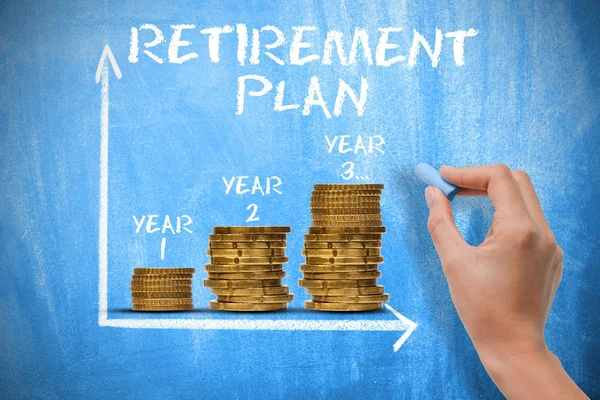Retirement planning is a financial journey that necessitates astute strategies tailored to each stage of life. Investing for retirement at every age demands not just foresight but also adaptability. This comprehensive guide will illuminate the intricacies of retirement investments, delineated by age brackets, to empower you with the knowledge needed to secure a prosperous retirement.

In this in-depth guide on how to invest for retirement, you’ll learn:
- Why retirement investing is different from other types of investing.
- How to determine the amount of money you need for retirement.
- How to choose the best retirement plan.
- The best asset allocation for retirement investing.
- Tips for building, growing, and managing your retirement portfolio.
Table of Contents
- 1 The Perennial Power of Investment
- 2 Investing in Your 20s: The Foundation Phase
- 3 Investing in Your 30s: Navigating Life’s Crossroads
- 4 Investing in Your 40s: The Fine Art of Balance
- 5 Types Of Retirement Accounts To Consider
- 6 Why retirement investing is different from other types of investing
- 7 Tips For Successful Retirement Investing
- 8 How to choose the best retirement plan
- 9 Conclusion
- 10 FAQs
The Perennial Power of Investment
Before we delve into age-specific strategies, let’s underscore the perennial power of investments. At its core, investing is the art of wealth multiplication. It’s akin to planting a financial seed, nurturing it with time and prudent decisions, and ultimately reaping the harvest in your retirement years. The adage “the earlier, the better” couldn’t be more apt when it comes to investing. The concept of compound interest, often cloaked in complexity, is, in fact, elegantly simple. It’s the interest earned on both the initial principal and the accumulated interest from previous periods. This exponential growth curve accentuates the need for early initiation of investment plans.
Investing in Your 20s: The Foundation Phase
Embrace Financial Foresight
In your twenties, financial independence often takes center stage. But strategic investing is a crucial facet of this independence. It’s a time when you must cultivate the foresight to see beyond the immediate horizon. Begin by establishing an emergency fund to buffer against unexpected expenses. Allocate a portion of your income to this fund, securing a financial safety net.
Harness the Potential of Equities
Equities, or stocks, can be the cornerstone of your investment portfolio. Their propensity for high returns, albeit with commensurate risk, is particularly beneficial for long-term investors. Consider diversifying your holdings, not just within stocks but also across asset classes, including bonds and real estate investment trusts (REITs).
Maximize Tax-Advantaged Accounts
Take full advantage of tax-advantaged retirement accounts, such as the 401(k) in the United States. These accounts provide not only a tax shelter for your contributions but also, in some cases, employer matching. It’s akin to free money that can bolster your retirement nest egg.
Expand Your Investment Horizon
Your thirties often bring forth additional financial responsibilities, like mortgages and family obligations. To meet these commitments and still prioritize retirement, consider augmenting your investment efforts. Increase your savings rate as your income grows, funneling a significant portion into your retirement accounts.
The Roth IRA Advantage
A Roth IRA offers a unique advantage – tax-free withdrawals in retirement. It’s a tax diversification strategy that can be particularly beneficial if you anticipate higher tax rates in the future. Consider opening a Roth IRA alongside your employer-sponsored plan to optimize your tax efficiency.
Regular Portfolio Reassessment
The landscape of investments is dynamic, and your portfolio should reflect this dynamism. Regularly review and adjust your investments to ensure they align with your financial goals and risk tolerance. The goal is to maintain equilibrium and respond appropriately to market fluctuations.
Investing in Your 40s: The Fine Art of Balance
The Catch-Up Contributions
In your forties, retirement might loom closer on the horizon. To bolster your retirement savings, take full advantage of catch-up contributions offered in retirement accounts. These additional contributions can significantly enhance your retirement readiness.
A Nuanced Approach to Risk
As you approach retirement, your risk tolerance may evolve. Consider shifting your investment strategy toward a more conservative stance to safeguard your accumulated savings from market volatility. Balancing growth and preservation becomes paramount.
Crafting a Holistic Retirement Plan
A comprehensive retirement plan is the culmination of your efforts. Collaborate with a financial advisor to create a meticulously tailored plan. This plan should encompass your retirement goals, projected expenses, and strategies for generating retirement income. The aim is to ensure a seamless transition into retirement, where financial stability reigns.
Types Of Retirement Accounts To Consider
Something else that’s different about retirement investing is the fact that there are specific types of accounts set up under our tax code that provide valuable tax advantages.
The most popular of these are:
- Individual Retirement Accounts (IRAs): An account you can set up on your own.
- 401(k) and 403(b): A retirement account that’s offered by an employer. Some employers even match your contributions up to a certain percentage of your salary; if so, that makes these accounts the ideal place to start saving.
If you’re self-employed, there are good options available as well. These include an SEP IRA or a solo 401(k), which offer similar tax benefits.
For both IRAs and 401(k)s, you can choose to invest in a Roth or traditional account.
- Roth IRA: You contribute after-tax money, and both your contributions and earnings can be withdrawn tax-free after age 59 ½.
- Traditional IRA. You contribute pre-tax money and then pay taxes upon withdrawal.
The tax savings provided by these accounts offer some significant advantages. However, they do come at the cost of liquidity. There are penalties (and in most cases, taxes) for withdrawing money from these accounts prior to retirement.
Depending on your situation, one account type will be better than the other. Overall, a Roth makes sense if you believe your tax rate is lower today than it will be at the time of withdrawal. Conversely, a traditional account makes more sense if you believe your tax rate is higher today than it will be at the time of withdrawal.
Why retirement investing is different from other types of investing
Retirement investing is different from other types of investing in a few key ways:
- Time horizon: Retirement investing is a long-term investment strategy. You are saving money for a time when you will no longer be working and will need to rely on your savings to live. Other types of investing, such as investing for a down payment on a house or a child’s education, may have a shorter time horizon.
- Risk tolerance: Retirement investors typically have a lower risk tolerance than other types of investors. This is because they are saving for a specific goal and they don’t want to risk losing their money. Other types of investors, such as young adults who are saving for a down payment on a house, may have a higher risk tolerance because they have more time to recover from any losses.
- Tax advantages: Retirement savings accounts, such as 401(k)s and IRAs, offer a number of tax advantages. For example, contributions to these accounts are typically tax-deductible and withdrawals in retirement are taxed as ordinary income, which is often lower than the tax rate on income during working years. Other types of investments, such as brokerage accounts, do not offer these same tax advantages.
Tips For Successful Retirement Investing

Here are some tips for successful retirement investing:
- Start early. The earlier you start saving for retirement, the more time your money has to grow. This is due to the power of compound interest.
- Invest consistently. Even if you can only save a small amount each month, it will add up over time.
- Diversify your portfolio. This means investing in a variety of different asset classes, such as stocks, bonds, and cash. This will help to reduce your risk.
- Rebalance your portfolio regularly. This means selling some of your winners and buying more of your losers to maintain your target asset allocation.
- Monitor your investments regularly. Make sure your portfolio is still aligned with your goals and risk tolerance.
Here are some additional tips:
- Take advantage of tax-advantaged retirement accounts, such as 401(k)s and IRAs. These accounts offer a number of tax benefits that can help your money grow faster.
- Consider working with a financial advisor. A financial advisor can help you develop a retirement plan and choose the right investments for your needs.
- Don’t panic sell. It’s normal for the stock market to go up and down. If the market takes a downturn, don’t sell your investments out of fear. Instead, stay calm and stick to your investment plan.
- Have a plan for retirement. How much money will you need to live comfortably in retirement? What sources of income will you have? It’s important to have a plan in place so you can enjoy your retirement years.
Retirement investing can be complex, but it is important to remember that it is a necessary part of financial planning. By following these tips, you can increase your chances of success.
How to choose the best retirement plan
The best retirement plan for you will depend on your individual circumstances, such as your age, income, risk tolerance, and retirement goals. However, there are some general factors to consider when choosing a retirement plan:
- Type of plan: There are two main types of retirement plans: employer-sponsored plans and individual retirement accounts (IRAs). Employer-sponsored plans, such as 401(k) and 403(b) plans, are offered by employers and offer a number of benefits, such as tax-deductible contributions and matching contributions from employers. IRAs are individual retirement accounts that you can open on your own. There are two main types of IRAs: traditional IRAs and Roth IRAs. Traditional IRAs offer tax-deductible contributions, while Roth IRAs offer tax-free withdrawals in retirement.
- Fees: Retirement plans can have a variety of fees, such as investment fees, administrative fees, and early withdrawal penalties. It is important to compare the fees of different plans before you choose one.
- Investment options: Retirement plans offer a variety of investment options, such as stocks, bonds, and mutual funds. It is important to choose a plan that offers investment options that are aligned with your risk tolerance and investment goals.
- Other features: Some retirement plans offer additional features, such as loans and hardship withdrawals. It is important to consider these features when choosing a plan.
If you are not sure which retirement plan is right for you, it is a good idea to talk to a financial advisor. A financial advisor can help you assess your individual needs and choose the right plan for you.
Conclusion
In sum, the journey of investing for retirement is akin to an ever-evolving symphony. Each stage of life brings its unique notes and nuances. Initiating your retirement investments in your twenties, harnessing the benefits of compound interest, and diversifying your holdings are the opening crescendos. As you traverse your thirties, expanding your investments, contemplating Roth IRAs, and maintaining a dynamic portfolio form the melodic interlude. The forties herald the grand finale, characterized by catch-up contributions, nuanced risk management, and the creation of a comprehensive retirement opus.
Retirement planning is not a one-size-fits-all endeavor; it’s an artistry that adapts to the canvas of your life. The investment decisions you make today will paint the portrait of your retirement tomorrow. Therefore, commence your symphony of investment with the first notes of wisdom, and let it crescendo into a retirement of financial abundance and security.
FAQs
Here are some frequently asked questions about how to strategically invest for retirement at every age:
Q: When should I start saving for retirement?
A: The earlier you start saving for retirement, the better. This is because of the power of compound interest. Compound interest is when your earnings on your investments also earn interest, creating a snowball effect. The longer your money has to grow, the more time it has to compound.
Q: How much money should I save for retirement?
A: The amount of money you need to save for retirement will depend on a number of factors, such as your age, income, expenses, and retirement goals. However, a good rule of thumb is to aim to save at least 10-15% of your income each year for retirement.
Q: What are the different types of retirement accounts?
A: There are two main types of retirement accounts: employer-sponsored plans and individual retirement accounts (IRAs). Employer-sponsored plans, such as 401(k) and 403(b) plans, are offered by employers and offer a number of benefits, such as tax-deductible contributions and matching contributions from employers. IRAs are individual retirement accounts that you can open on your own. There are two main types of IRAs: traditional IRAs and Roth IRAs. Traditional IRAs offer tax-deductible contributions, while Roth IRAs offer tax-free withdrawals in retirement.
Q: How do I choose the best retirement plan for me?
A: The best retirement plan for you will depend on your individual circumstances, such as your age, income, risk tolerance, and retirement goals. However, some general factors to consider when choosing a retirement plan include the type of plan, the fees, the investment options, and other features, such as loans and hardship withdrawals.
Q: How should I invest my retirement savings?
A: The best way to invest your retirement savings is to create a diversified portfolio. This means investing in a variety of different asset classes, such as stocks, bonds, and cash. This will help to reduce your risk. You should also consider your risk tolerance and time horizon when choosing your investments.
Q: How often should I rebalance my retirement portfolio?
A: You should rebalance your retirement portfolio regularly to maintain your target asset allocation. This means selling some of your winners and buying more of your losers. How often you need to rebalance your portfolio will depend on your individual circumstances.
Q: What should I do when I retire?
A: When you retire, you will need to start withdrawing money from your retirement savings to live on. You should have a plan in place for how you will withdraw your money. You may also want to consider working with a financial advisor to help you manage your retirement income.
Retirement planning can be complex, but it is important to remember that it is a necessary part of financial planning. By following these tips, you can increase your chances of success.









